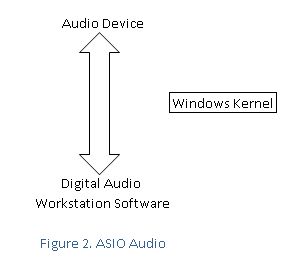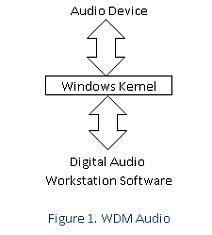ASIO (Professional audio device drivers)
ASIO is the professional solution to digital recording. ASIO works by bypassing the Windows kernel and directly accessing and communicating with the audio device (such as an audio interface) such as shown below:

What is one big advantage about using ASIO is that the bit depth and sample rate are preserved as originally as possible since it cannot be altered by Windows kernel/Mixer. For example if you are recording at 24-bits/48KHz, the recorded audio is exactly 24-bit/48KHz digital audio.
ASIO driver is different from WDM drivers in such a way that the stability of these drivers exactly depends on the quality of the hardware drivers. Unlike WDM where its dependent on Windows kernel, ASIO based drivers are independent on how Windows kernel works.
This leads to lowered CPU processing, lower latency and memory usage. With ASIO, multi-channel recording is possible (more than 2 channels) because of decreased load on Windows kernel and by directly accessing the audio hardware.
This will have a profound effect on reducing audio dropout and multi-track recording latency.
Best practices in using ASIO or WDM
1.) WDM is restricted to non-professional music production environment because of latency and recording quality related issues. If you analyzed carefully how WDM audio drivers work, it will communicate with the Windows kernel first before reaching the audio to its intended destination (like recording software); thus adding latency in the process.
Also WDM will implement sample rate conversion and bit depth in the background which can alter the quality of the recorded audio stream. High latency is not recommended for professional digital home recording because these can introduce lag and timing issues in your multi-track recording project.
2.) If the objective in using audio is gaming or non-recording related applications where high latency is acceptable, you can stay with your WDM device as it will usually offer a cheaper hardware solution.
3.) When recording a high number of channels simultaneously, such as recording a live band; you need a high bandwidth solution in communicating between your audio interface and the computer. For very high bandwidth implementation, you can use Firewire or USB 2.0 and USB 3.0. If you are using Windows operating system, you can read this tutorial on how to optimize Windows XP for firewire & USB audio interface.
4) There are some recordings software that only supports WDM drivers (like Adobe Audition 1.5). In this case, you cannot use them for ASIO multi-channel recording (targeting low latency implementation); you need a DAW software that can support ASIO drivers. A good example is Reaper. Below is a screenshot of REAPER configured to use ASIO drivers from Saffire Pro 40 audio interface:

Read this Reaper DAW tutorial to know the details on how to associate ASIO with your digital audio workstation software.
5.) WDM is the most recommended solution for desktop and consumer audio applications for your computer (mp3 streaming, internet audio streaming, gaming, movies, etc.). ASIO is the most recommended solution for professional music productions using your computer.
6.) ASIO can only handle a single audio hardware at a time. So if the computer has multiple audio devices, they cannot be used because ASIO can only be associated with one ASIO device at a time. This is different with WDM which can support multiple soundcards or audio devices.
Content last updated on July 23, 2012









6 Responses
I’m just getting back into DAW recording, I have Sonar 6, an Amd fx 8320e, eight gigs of ram. I used the Asoi drivers, but still I get dropouts. But, with the Wdm drivers, I have no problems at all, and can change bit dept and resolutions. I keep pushing my DAW with many plug-ins, so far so good.
Thanks David, sad to say but I have to agree with this. No drivers can be made perfect no matter what. some old school might still say Analog is still best and you won’t be dealing with these software drivers ever. But this looks like an unavoidable reality. The truth is, one can be get easily started with building a home studio based on a computer today. But they have to deal with all these driver issues. It’s cheaper as well based from what I’ve observed when compared to real analog technology.
The real problem in my years of working with this stuff Software and hardware (audio interfaces) is the drivers being incorrectly created by engineers not completely following and even thoroughly testing the drivers they ship with the products. 99% of the issues quality, latency, and rock solid connectivity issues are directly related to this ongoing problem. The advancement of technology over the last 10-12 years hasn’t drastically improved or totally resolved this fact. Manufacturers and tech support people always want to blame your computer system for this. Not enough RAM or CPU not sufficient. Mostly, this response is hogwash and BS. I currently work in my studio with a Quad Core Intel Zeon 3.1Ghz processor – 8 cores for Hyperthreading and 32GB of RAM and I still have driver issues. Some interfaces are better than others, but I’ve tried Tascam, Focusrite, Steinberg, Behringer, PreSonus, and Roland interfaces and they all have issues from time to time. Most of them just losing contact with the device itself for no apparent reason. This also relates to the Audio Engine in the software suddenly stopping or crashing. Again all driver related. My advice – make sure whatever audio interface device you choose make sure they produce driver revisions and updates often. Many drivers are 1-2-3 years old and never improved much from the entire lifetime the device is on the market.
Hi Tony,
Yeah it’s alright. I also drink two cups of coffee just this morning to energize things up 🙂 Happy New Year!
Woops, sorry, confused WASAPI with WDM… All the points i made were for WASAPI. Didn’t have enough coffee, i guess… :-/
A few corrections.
First, WDM driver wasn’t there until Windows Vista. Windows 98 had different (and MUCH slower) model for accessing audio devices, which involved not only Windows kernel, but also Windows mixer and other stuff.
Second, there’s nothing wrong with sound having to pass through kernel, because that’s what it does in any case. ASIO does that too. ASIO, just as WDM, is a driver, hence it is loaded by the kernel and hence audio gets to the kernel one way or another. The difference between ASIO and WDM is with ASIO driver you get to choose exactly how much latency you can get (buffer length etc.) while WDM just tries its best.
Finally, WDM can achieve comparable (if not equal) latency with ASIO, and bit depth/sample rate conversion can be turned off (just as the same can be turned on in many ASIO drivers). WDM can also be used with “prosumer” equipment (i use WDM driver with my M-Audio gear just fine) with little to none problems and latency issues, plus the added benefit of being able to use audio devices in different programs simultaneously.
I enjoy reading technical articles, but please get your facts straight first.